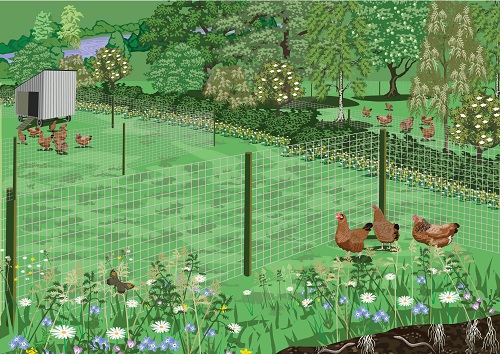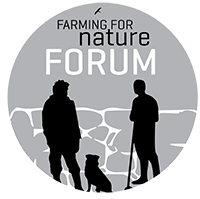POULTRY
Here are some practical ways to take climate action and enhance biodiversity on your poultry farm
Climate & Biodiversity actions full doc (pdf)
Poultry section only (pdf)
1.Energy & fuel
Maximising energy efficiency and moving away from fossil fuels are two ways in which poultry farms can minimise their carbon footprint –
- Consider renewable energy – a shed roof can be the ideal place to install solar panels and supports are increasingly available
- Mend leaky pipes and troughs – drinking water production and supply requires energy yet >43% of treated drinking water in Ireland is lost to leaks
- Choose suppliers that minimise plastic packaging – plastics are produced using fossil fuels
- Explore new opportunities for ground source heat pumps
- Improve building insulation and ventilation – being able to effectively control internal temperature can lead to less energy wastage
- Consider less intensive management systems – pasture-based systems can reduce energy costs
- Regularly check that thermostats are clean, free-from droughts and operating correctly
- Turn off the lights! – utilise natural light where possible and LED bulbs when artificial light is necessary
- Reduce transport emissions from feed by growing feed crops on the farm where possible, or by buying from a local tillage farmer or horticulturalist
Co-benefits for farmers
- Reduced fuel and input costs
- Reduced energy costs
- Improved farm self-sufficiency and climate resilience
- Increased resilience to market forces (feed & fertiliser costs)
- Increased animal welfare and market price
2. Trees, scrub & hedgerows
Woody vegetation captures and stores carbon.
- Where possible, plant native trees around the production areas, driveways, sheds and farmyard
- In pasture-based systems, allow for natural regeneration of trees and scrub in less productive areas of the pasture
- Plant native hedgerows
- Allow existing hedgerows to grow tall and wide
- Experiment with agroforestry/silvopasture to build a climate resilient farm system
- Diversify farm enterprises by planting a native woodland
- Retain, enhance or create woodland areas, copses and scrubland
Co-benefits for farmers
In a poultry farming system woody vegetation can:
- provide enrichment
- provide shade & shelter
- improve animal welfare
- enhance biodiversity
- diversify farm enterprises
- create a positive working environment
“The trees which we planted are now 4 years and older. They are started to really give shape to the farm and wind protection. Also seeing a noticeable increase in bird life around the farm. We have planted the trees in the hedges to thicken them up and then we have broke a lot of the fields into 20meter lanes. These are giving us a lovely structure to the farm and in time no doubt will help with adding structure underground.” Fergal Smith, Mixed stock farmer & FFN Ambassador, Co. Clare.
3. Soil
Healthy soils store carbon.
While pasture-based systems can use less energy than indoor systems, it is important to also consider how they impact on your soil.
- Healthy, undisturbed soils store carbon – retain soil carbon by minimising ploughing and reseeds
- If growing your own feedstuffs, consider no- or min-till and the use of multi- and cover-crops
- Choose breeds wisely – traditional poultry breeds (habitat adapted) can be more suitable for pasture-based outdoor systems and can require less supplementary feedstuffs
- Plant species-rich swards to naturally fix nitrogen, improve drainage and build flood and drought tolerance
- Reduce grassland management intensity to allow sward diversity to develop naturally
- Avoid compacting your pasture with increasingly heavy farm machinery
- Rotate pastures and consider mixed-grazing to maintain sward and soil health
- Maximise natural food sources (e.g. promote insect life) to minimise the need for imported feed – our use of imported feeds is contributing to rapid destruction of the rainforest in Brazil
Co-benefits for farmers
Healthy soil
- increases pasture yields
- retains more moisture (making pasture more drought tolerant)
- drains better (making pasture more flood resistant)
- supports more soil microbes (which in turn store more carbon and lead to even healthier soils)
4. Nutrient management
A nutrient management plan can both help you to reduce your carbon emissions from manure and litter) and increase efficiency in the use of any fertilisers (e.g. if you are growing your own feedstuffs).
- Improve welfare – healthy birds have better feed conversion rates, meaning reduced feed input
- Treat your manure with respect! – organic manure is an increasingly valuable farm asset, don’t allow it to be wasted!
- Using poultry manure on-farm to help grow your own feed can greatly reduce transport and production emissions.
- Covering manure heaps will reduce both emissions and run-off
- In pasture-based systems, retain, enhance and create buffer strips and hedgerows to help prevent nutrient run-off
- Where possible, use low emissions slurry spreading and maximise nutrient uptake by crops by maintaining optimum soil pH
- To maximise nutrient absorption, spread fertiliser, slurry and farmyard manure on warmer days (soil temp at least 6°C)
- Include nitrogen fixing legumes in swards or feed crops (e.g. clover, vetch, beans)
- If fertilising feed crops, use protected urea rather than CAN
- Mobile phone operated GPSs and tractor sensors can help to maximise nutrient uptake through more targeted spreading
Co-benefits for farmers
- Maximising use of a valuable asset
- Decreased fertiliser use (lower costs)
- Increased farm self-sufficiency (lower external inputs)
- Decreased vulnerability to market forces (fertiliser costs)
5. Water management
Our water bodies (rivers, lakes and oceans) naturally work together to support biodiversity and to store carbon. When water bodies are polluted, these systems break down. Almost half of Irish surface waters are not in good health and the situation is deteriorating. Help to restore our water bodies by eliminating harmful farm run-off:
- List the potential sources of run-off from your farm and how you might eliminate them. Some of these (e.g. chicken manure) are more obvious than others (e.g. spoil from tractor tyres, washings or waste feed)
- Keep clean run-off e.g. (from shed roofs and clean paved areas) separate from soiled water
- Spread soiled water in dry fields far from water-courses
- Reduce nutrient run-off from pasture-based systems: plant buffer strips, field margins and hedgerows to slow the flow of nutrients; create a wetland to soak up and filter excess run-off after heavy rain
- Never spread or spray inputs when rain is due
- Treat your chemicals with respect – just one drop of pesticide can pollute a small stream for over 30kms!!
- Reduce herbicide use by using alternative methods of weed control e.g. non-synthetic herbicides, topping, diverse crop rotations. As many synthetic herbicides are water soluble (e.g. MCPA, 2,4-D), it is almost impossible to ensure they do not end up in watercourses after application.
- In mixed-grazing rotations, fence livestock well back from watercourses; don’t allow stock to drink directly from rivers; avoid poaching and pinch points
Co-benefits for farmers
- Reduced input, labour, fuel and machinery costs
- Cleaner water and good health – research has detected herbicides in 38% of drinking water wells tested in Ireland.
- Habitats – cleaner water benefits humans and nature alike
Curious? Have you run the numbers for a reduced stocking rate or for going organic?
Reduced stocking rates: with the current shift in farm payments away from production and towards environmental measures, could reducing the intensity of your farming system now make sense from both climate and financial perspectives?
Going organic: Have you run the numbers for going organic? New supports and a growing market are making this an increasingly attractive option for poultry farmers.
Nature co-benefits
“Nature has been the foundation of productive systems for millennia. Enhancing nature on your farm is actually building your resource into the future. Biological diversity or a strong natural system builds resilience to extremes of weather or climate change” Sean O’Farrell, Mixed-stock (poultry, pigs, cattle, goats) farmer & FFN Ambassador, Co. Tipperary.
Climate action on poultry farms can benefit nature by creating:
- More species-rich and diverse landscapes, supporting native fungi, insects, birds, mammals and more!
- Healthier rivers, lakes, estuaries and oceans, rich with life
- Habitat for our native species to feed and breed
- Nature-rich farms – loud with humming insects and singing birds
- A model for other poultry farmers; when we experience nature on another farm we are more likely to want to protect it on our own!
Nothing beats nature for providing natural climate change adaptation and mitigation. Boosting biodiversity, from the soil to the treetops, will help your farming system to remain productive and resilient in the face of increasingly unpredictable weather events.


